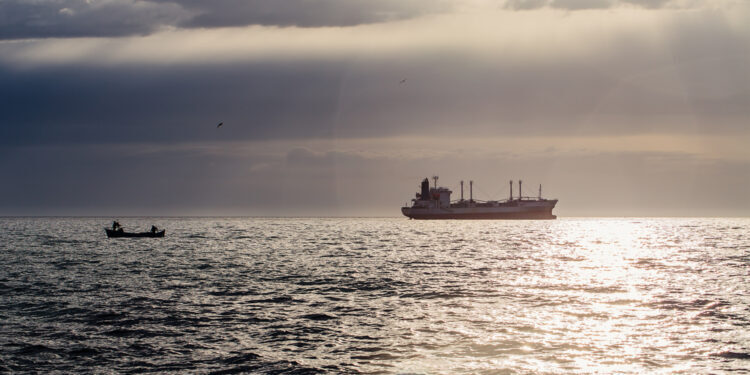
Credit: Shutterstock
In view of the summer fishing ban lifting on 16 August, the Bahamas Maritime Authority shared recent guidelines to be issued by the China Maritime Safety Administration on the prevention of collisions between merchant ships and fishing vessels in Chinese coastal waters, including Taiwan Strait, East China Sea or Yellow Sea.
Collisions between merchant ships and fishing vessels and fishing fleet support vessels in Chinese coastal waters continue to result in a large number of fatalities. Two collisions involving Bahamian ships resulted in 24 fatalities in 2018-2019.
Lessons learned from previous casualties
- Passage planning – probable traffic conditions should be risk assessed and critical areas identified as part of the appraisal. Effective control measures could include adjusting the passage to avoid high traffic areas, planning work to make senior watchkeepers available on the bridge for the transit of high risk areas or strategic use of the time available to reduce speed on high risk legs.
- Bridge resources – watchkeepers should be aware of the function of all available tools to assess risk of collision and support decision making.
- Navigating in dense traffic – if documented procedures such as reducing speed or maintaining minimum CPA are not applied consistently, perceived risk can reduce resulting in greater risk taking.
- Action to avoid collision – needs to be early, substantial and easily seen by another vessel. Use of the appropriate sound signal helps clarify the action being taken and visually monitoring the effectiveness of action taken is vital.
- Near miss or collision? – if there is any indication that a collision has occurred, it is essential to find out conclusively and render assistance as required.
Safety guidelines
-Before entering the waters where fishing vessels are concentrated
- The captain should examine the passage plan, as far as practicable adopt the recommended route and try the best to avoid entering the fishing vessels concentrated waters, so as to reduce the chance of encountering fishing vessels.
- Examine and test navigational aids and communication equipment such as RADAR, ECDIS/ECS, AIS, VDR, VHF, Navigational lights and sound-signaling equipment to ensure that all are in sound working condition.
- Make proper arrangement on navigational watch. There should be at least 2 crew members engaged on the bridge watch at all times. Safety precautions and corresponding actions guide for navigating in the fishing area should be clearly posted at a prominent position on the bridge.
Navigating in or approaching to the waters where fishing vessels are concentrated
- It should be borne in mind that: Safety First, Don’t take risks, Take a detour! As far as practicable avoid entering the waters where fishing vessels are concentrated.
- Appropriate bridge watch arrangement shall be made. The number of bridge team may be increased according to the high traffic density of fishing vessels. Don’t hesitate to call the captain to the bridge any time in doubt.
- The captain should issue the night orders in response to the special precautionary requirements for the safe navigation in the fishing area at night time.
- The bridge should keep a sharp look-out, use two or more radars by long-range and short-range scanning. Do not rely too much on a single navigational aids, every vessel shall at all times maintain a proper look-out by sight and hearing as well as by all available means appropriate in the prevailing circumstances and conditions.
- Proceed at a safe speed at all times.
- Make sure the AIS information is updated and the device is in good working condition
- All measures shall be taken to avoid watchkeepers to work in fatigue or after drinking.
Special Precautions
- When the summer fishing moratorium ends,usually it is the time when the density of fishing vessels is highest.
- Based on accident statistics, most collisions between merchant vessels and fishing vessels occur in the period between 2300 and 0400. Therefore special attention should be given in this duration.
- Special attention should also be paid to some fishing vessels anchored at night which might not arrange watchkeepers or display proper lights or have operational AIS as required, and also to the interference from the excessive use of AIS on fishing nets or fishing marks.
- When a fishing vessel is observed proceeding at the speed around 3 knots, she is possibly engaged in fishing and restricted in her ability to manoeuvre, keep clear at a safe distance whenever possible.
- Even a slight collision or contact between a merchant vessel and a fishing vessel might capsize the fishing vessel and cause subsequent damage to both the vessel and her crew. However, it is sometimes hard to be observed by watchkeepers on merchant vessels. Therefore, When passing a fishing vessel at close range, great care should be taken to ensure that there is no collision, wave damage or vessel suction.
- It is recommended that vessels sailing from the southern parts of the South China Sea to Japanese or Korean ports, and vessels that do not call at Chinese ports, proceed from the waters east of Taiwan Island and try to stay away from the coastal waters of China.
SOURCE READ THE FULL ARTICLE
https://safety4sea.com/china-safety-guidelines-for-preventing-collisions-of-ships-with-fishing-vessels/